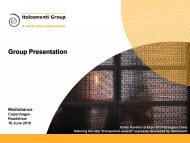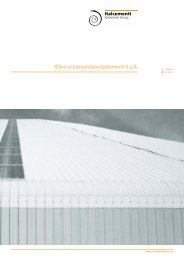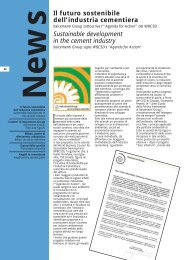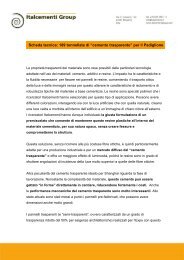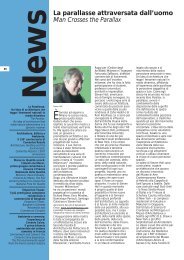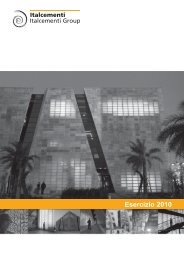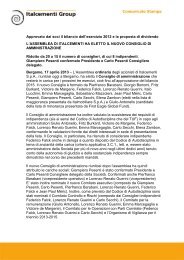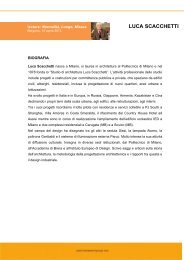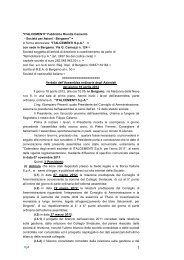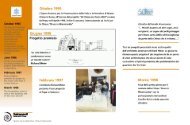2012 Annual Report - Italcementi Group
2012 Annual Report - Italcementi Group
2012 Annual Report - Italcementi Group
Create successful ePaper yourself
Turn your PDF publications into a flip-book with our unique Google optimized e-Paper software.
The analysis, prepared upon instruction of the Director in Charge of the Internal Control and Risk Management<br />
System and with the support of the Chief Risk Officer, details the level of expected risk in each Country where<br />
the <strong>Group</strong> operates, as well as the various kind of risk, dividing them into two main categories: those that are<br />
independent from the determination and the conduct of the Company (general economic situation, political<br />
risks, etc.) and those that may be mitigated as a result of appropriate measures undertaken by the Company<br />
itself.<br />
In light of the quantification of expected risks, the Board of Directors determines the level of exposure to risk<br />
considered acceptable and consistent with the strategic objectives it has defined.<br />
Risk exposure, as measured during the preparation of the budget, is constantly monitored both at <strong>Italcementi</strong><br />
and <strong>Group</strong> level; for this purpose each Primary Risk Owner prepares a half-yearly report that ranks the most<br />
significant risks and, where appropriate, modifies the corresponding mitigation plan previously prepared. The<br />
Board of Directors and the Control and Risk Committee are kept informed by the Chief Risk Officer on the<br />
evolution of risks and their subsequent mitigation.<br />
In addition to the risk analysis conducted in view of the approval of the annual budget, every strategic plan of<br />
the Company is preceded by a risk analysis that includes the definition of best and worst case scenarios, the<br />
chances of achieving a profit, given by an expected confidence level, and the expected impact of each type of<br />
risk, also in light of a series of measures to mitigate risks in regard of which the Company may take action with<br />
appropriate measures.<br />
4. Description of the main features of the Internal Control and Risk Management System in regard of<br />
the financial reporting process<br />
4.1 Phases of the risk management and internal control system<br />
The risk management and internal control system mitigating risks in relation to the financial reporting process<br />
consists of a set of corporate rules and procedures, adopted by the various operating structures, aimed at<br />
ensuring trustworthiness, accuracy, reliability and timeliness of financial reporting.<br />
<strong>Italcementi</strong> has defined its own reference Model for the assessment of the Internal Control and Risk<br />
Management System related financial disclosure (hereinafter, in short, “Operational Model”), detailing the<br />
operational approach for the performance of activities. This Model is based on the principles contained in the<br />
CoSO framework and in the document “Internal Control over Financial <strong>Report</strong>ing - Guidance for Smaller Public<br />
Companies”, also developed by CoSO.<br />
In this Model, the risk control system is considered together with the internal control system in relation to the<br />
financial reporting process.<br />
The Operational Model defined by <strong>Italcementi</strong> is based on the following main elements:<br />
a) Preliminary analysis. This activity, carried out on an annual basis and whenever deemed necessary, is<br />
aimed at identifying and assessing the risks related to the Internal Control and Risk Management System<br />
with regard to financial reporting, in order to determine priorities for action related to documentation,<br />
assessment and testing of administrative and accounting procedures and related controls. The identification<br />
of the relevant quantities and processes is based on quantitative (weight of revenue and assets of a single<br />
entity on consolidated amounts, the carrying amount of consolidated financial statement items related to a<br />
particular process) and qualitative (the Country in which an entity operates, specific risks, risk levels<br />
assigned to the various items) factors;<br />
b) Operational planning. Every year the activities are planned on the basis of the priorities identified through<br />
the preliminary analysis and other assumptions, if any;<br />
c) Analysis of controls at company level. Single entities, within the area of action identified in the<br />
166



